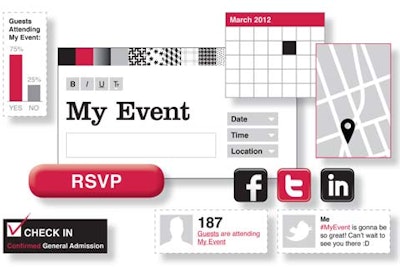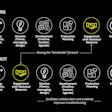
Today’s digital invitations do much more than just invite people to an event. Planners can use them to gather data on attendees, create separate distribution channels, track check-ins, and integrate social media.
Digital invitation providers are continually adding new features to their systems. And more choices means more decisions for planners to make. Ultimately, the quality and complexity of the final product depends on the time and effort invested long before the first invitation goes out. Here’s a look at some of the value-added services that are available from digital invitation systems and things to consider when developing a strategy for using them.
Design
Whether an invitation is done on paper or in pixels, decisions about color, fonts, and artwork are critical to the overall look and feel. Initially most digital invitations were created from templates, a fast and easy solution that left little room for originality. Now digital invitation providers offer a variety of options for custom designs. Online systems provide a do-it-yourself solution that can still result in a custom look for the finished product.
Kristie Vento, creative director of the Venue Marketing Group in Dallas, used Eventbrite to create invitations for nearly 20 events during 2011. “All of our events have custom backgrounds,” Vento says. “There is almost nothing Eventbrite about it. It looks like a custom invitation.” Planners who need help through the process can get support online and by phone.
Cvent provides a content analysis tool. “We will score the invite on a scale of one to 10 on the likelihood of that email getting into someone’s inbox. Then we show them how to clean it up,” says Cvent vice president Brian Ludwig.
For planners looking for greater customization, companies such as Event Farm can create a unique Web site that provides details about the event and links to an online registration system. “We see it as an opportunity to brand your event,” says Event Farm C.E.O. Ryan Costello. “Your invite should do much more than ask, Are you coming or not? It should be able to engage your crowd and explain what you are trying to do.” A Web site such as this can remain online after the event, providing a central source for follow-up information, event photos, and details about future events.
Data
The growth of digital invitation systems has been fueled in part by planners’ desires to capture data about attendees. For some it may be as simple as asking about meal preferences or transportation needs, while for others an online response form can ask questions that help determine the event’s schedule or content.
Ludwig says clients have used Cvent’s system to get feedback from groups of attendees. “The registration process can be different for each group. Maybe for a staff person, it will ask five questions, but no one else needs to see those. It’s about customizing the entire communication path, not just the invite,” he says.
Gathering R.S.V.P.s online creates an instant database of attendees that can streamline the check-in process and become a resource for future events. An electronic system can also track who opened the invitation and who didn’t, whether any bounced back as undeliverable, and whether the recipient forwarded it to others.
Distribution
Online platforms allow planners to customize distribution to different segments of their guest lists. Costello says this is particularly useful for an event that has multiple sponsors, each with an allotment of tickets. “We can give the sponsor an electronic block of tickets that they can send out to their guests and track the response status,” he says. “It allows the sponsor to coordinate their tables without having to involve the event planner.” Another option is to create an access code to manage different segments of the audience—for example, if some aspects of the invitation are available to the public while others are only for V.I.P.s.
Planners who want to be even more strategic in their event marketing can use online systems to personalize invitation messages and follow-up paths for each audience. “Maybe staff that is invited to an event should get a reminder email, but it might be a different strategy for a client group,” Ludwig says. “Or maybe just the people that sign up for golf should get an email two days before the event. Why force everyone to read everything when we can have the right emails going to the right people?” Ludwig says more people open emails when the “from” line is suited to the audience. “Prospects get their email from the vice president of sales, but the staff gets it from the C.E.O,” he says.
Distribution strategy hinges on what will work best for the audience. For a nonprofit gala in the Boston area last October, Corinthian Events program manager Victoria Gillot says her client was not ready to embrace a fully digital invitation process. Instead, the client mailed printed invitations and then used Event Farm’s system to track responses and manage V.I.P. check-ins. “I think it is a valid concern that people have, especially in the area of nonprofit sponsorship, worrying that clients aren’t savvy enough or that the electronic invitation will turn them off or seem like too much work,” she says. “But I’m hoping it’s not for much longer.”
Vento says she has had similar experiences. “While it’s quicker and easier and more cost effective to leverage technology, we still believe in the power of a traditional paper invitation for more formal events,” she says. Ludwig says he advises clients who are considering electronic and print to send the email first. “See what kind of response you get and then send the printed invitation afterwards to those who didn’t respond to email,” he says.
Check-In
Whether the invitation is distributed in printed form or electronically, the process of registering guests on site can be simplified using mobile check-in apps offered by most online systems. For a ticketed event, Eventbrite’s “Entry Manager” app turns an iPhone into a ticket scanner that reads a QR code on the ticket and captures data such as what time most guests arrive.
Gillot says she had success using Event Farm’s check-in app, even though she used paper invitations. “It was great to be able to check with one tap of a finger how many people had checked in so far. And if someone showed up with a guest that was not in the system, we could add the name and email, since we were most concerned with getting information about everyone that came through the V.I.P. registration,” she says. “And it’s still new enough that guests were impressed that we were checking them in with iPads.”
Planners can also configure the apps to send an alert when certain guests—a sponsor or member of the media, for example—arrive. To create efficiency with large groups of people, check-in can be done with self-serve kiosks at multiple entry points.
Social Media
Digital invitation systems create instant promotional opportunities. Online registration forms can instantly link to social media accounts. A registrant can let Facebook, Twitter, and LinkedIn contacts know he is attending an event. Some services take it a step further. Eventbrite employs “evangelists” in eight of its biggest markets who promote events in those cities via their social media connections.
Vento hosted a costume party in October to launch her new company, FreshMeet Media, and she credits Eventbrite’s built-in promotional system with helping her get extended PR for the event, including coverage on a Dallas TV station. “[Eventbrite evangelists] blogged about it, they tweeted about it, they posted about it in their newsletter, they Facebooked about it. It posted and was scrolling on Eventbrite.com so other cities commented on it. The evangelists got behind it, and they were my cheerleaders,” she says.



















